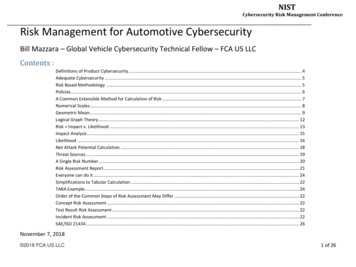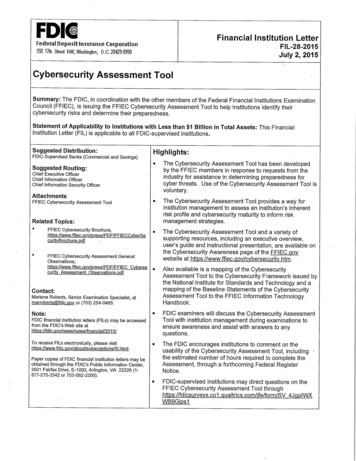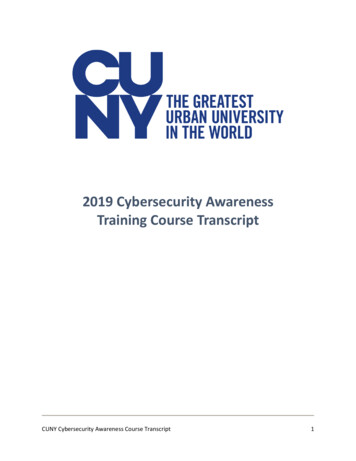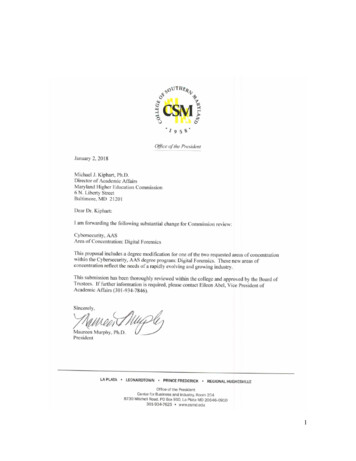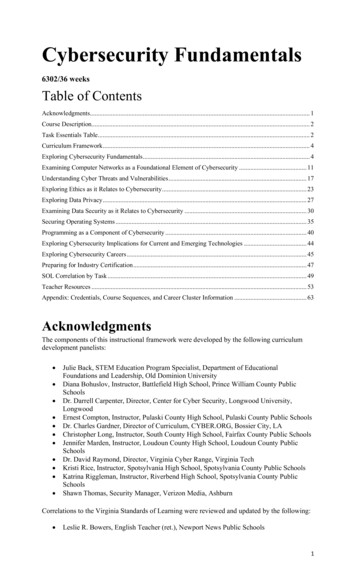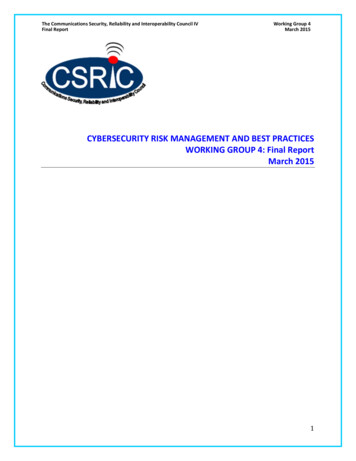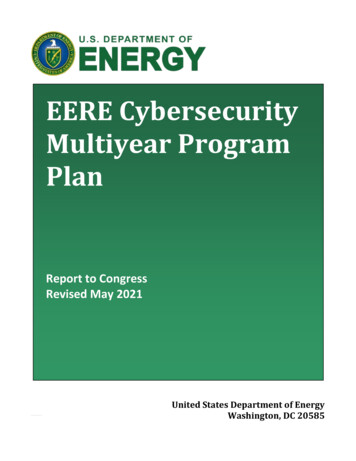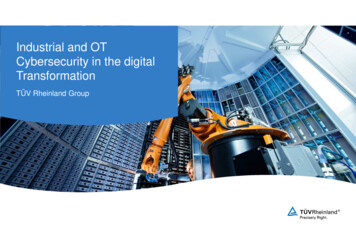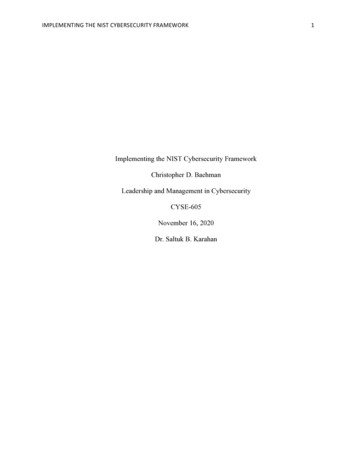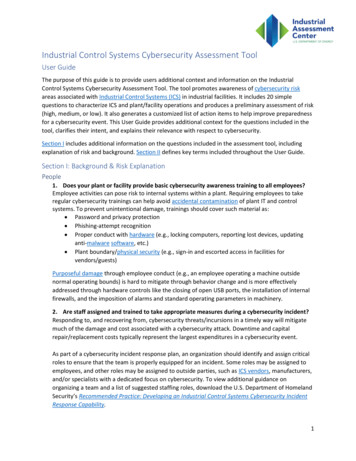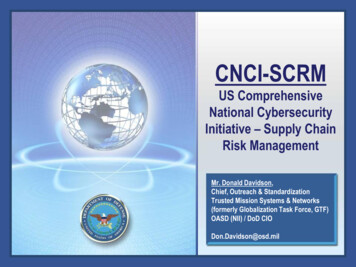
Transcription
CNCI-SCRMUS ComprehensiveNational CybersecurityInitiative – Supply ChainRisk ManagementMr. Donald Davidson,Chief, Outreach & StandardizationTrusted Mission Systems & Networks(formerly Globalization Task Force, GTF)OASD (NII) / DoD CIODon.Davidson@osd.mil
Focus Area 3Focus Area 2 Focus Area 1Comprehensive NationalCybersecurity Initiative (CNCI)Deploy PassiveSensors AcrossFederal SystemsTrusted InternetConnectionsPursue Deployment ofIntrusion PreventionSystemCoordinate andRedirect R&D Efforts(Dynamic Defense)Establish a front line of defenseConnect CurrentCenters to EnhanceCyber SituationalAwarenessDevelop a GovernmentWide CyberCounterintelligencePlanIncrease the Security ofthe Classified NetworksExpand EducationDemonstrate resolve to secure U.S. cyberspace & set conditions for long-term successDefine and DevelopEnduring Leap AheadTechnology, Strategies& ProgramsDefine and DevelopEnduring DeterrenceStrategies & ProgramsDevelop Multi-ProngedApproach for GlobalSupply Chain RiskManagementDefine the FederalRole for ExtendingCybersecurity intoCritical InfrastructureDomainsShape the future environment to demonstrate resolve to secureU.S. technological advantage and address new attack and defend vectors
CyberSecurity
Globalization brings challenges to DoD The government hassuppliers that it may notknow and may never see Less insight into suppliers’security practices Less control over businesspractices Increased vulnerability toadversaries“Scope of Supplier Expansion and Foreign Involvement” graphic in DACSwww.softwaretechnews.com Secure Software Engineering, July 2005 article “SoftwareDevelopment Security: A Risk Management Perspective” synopsis of May 2004 GAO-04-678report “Defense Acquisition: Knowledge of Software Suppliers Needed to Manage Risks”
Globalization brings challenges to DoD Acquirers The government hassuppliers that it may notknow and may never seeSystemsIntegratorsSuppliers Less insight into suppliers’security practices Less control over businesspractices Increased vulnerability toadversaries“Scope of Supplier Expansion and Foreign Involvement” graphic in DACSwww.softwaretechnews.com Secure Software Engineering, July 2005 article “SoftwareDevelopment Security: A Risk Management Perspective” synopsis of May 2004 GAO-04-678report “Defense Acquisition: Knowledge of Software Suppliers Needed to Manage Risks”Hardware (HW), Software (SW) & Services
and to Industry Many things are more challenging in a global environment whereICT supply chain gets less clear with each layer Intellectual property protection Assurance that you are buying authentic products Quality control in a global environment Gaining a desired level of assurance about sound business andsystem development/integration practices Etc USG refers to this challenge as global sourcing andsupply chain risk management
Today’s Reality of our Increased DependencyRequires an Increased Confidence in our ICT- Dependencies on technology are greater then ever-- Possibility of disruption is greater than everbecause hardware/software is vulnerable--- Loss of confidence alone can lead to stakeholderactions that disrupt critical business activities Agriculture and FoodEnergyTransportationChemical IndustryPostal and Shipping WaterPublic HealthTelecommunicationsBanking and FinanceKey AssetsCritical Infrastructure / Key ResourcesInternet users in the world: 1,766,727,004E-mail messages sent today: 215, 674, 475, 422Blog Posts Today: 458, 972Google searches Today: 2,302,204,936Who isbehind databreaches?74% resulted from external sources ( 1%).20% were caused by insiders ( 2%).32% implicated business partners (-7%).39% involved multiple parties ( 9%).How dobreachesoccur?7% were aided by significant errors ( ).64% resulted from hacking ( 5%).38% utilized malware ( 7%.22% involved privilege misuse ( 7%).9% occurred via physical attacks ( 7%).* Source – 2009 Verizon Data Breach Investigations Report Reservoirs Treatment Railroad Tracks plants Highway Bridges Farms Pipelines Food Processing Plants Ports Hospitals Cable Power Plants Fiber Production Sites FDIC InstitutionsChemical PlantsDelivery SitesNuclear power plantsGovernment FacilitiesDamsPhysical InfrastructureServices Managed Security Information ServicesControl Systems SCADA PCS DCSHardware Database Servers Networking EquipmentSoftware Financial Systems Internet Human Resources Domain Name System Web HostingCyber Infrastructure
Things that can go wrong Technologies are integrated without regard to the criticality and risk levelsof the parent system or network Vulnerabilities: All ICT (incl. systems, networks, applications) Intentionally implanted logic (e.g., back doors, logic bombs, spyware) Unintentional vulnerabilities maliciously exploited (e.g., poor quality or fragile code) Counterfeit components/products prematurely degrade / otherwise disrupt operations Adversary has increased access and opportunity to infiltrate otherwiseclosed-off technologies and services Consequences: Stolen critical data & technology; corruption, denial ofcritical functionality
SCRM Guiding Principles Defense-in-breadth: Mitigate risk across the entire lifecycle Understand risk management problem from a systems perspective Response should be commensurate with risk and system/network criticality Need to understand levels of vulnerability and threat relative to each system Investigate higher assurance characteristics of commercial productswhere we have leverage Continued access to global ICT is critical to DoD missionTo meet tomorrow’s threat we must develop protection measures acrossproduct lifecycle and reinforce these measures through USG acquisitionprocesses and effective implementation of agency security practices.
DoD Defense-in-Breadth Technical Toolbox:Systems Assurance Systems Engineering Guidance for Systems Assurance Maps ISSE, Anti-tamper/software protection, program protection planningto DoD acquisition/systems engineering lifecycle Identifies critical components for enhanced protection SCRM Key Practices Guide Implements Defense-in-breadth approach by identifying supply chain riskmitigation measures across entire lifecycle Trusted Access Program Office/Trusted Foundry Provides leading-edge DoD application specific integrated circuits (ASIC)from cleared foundries Software Assurance Software static analysis methodology and metrics Enhanced vulnerability detection R&D NDAA Section 254 - Report to Congress
Engineering for Systems Assurance Developed by AT&L and NII through NDIA SystemsAssurance Committee Intent of the Guidebook: Provide practical guidanceaugmenting systems engineering with systemsassurance practices Provide knowledge for applying technical assurancemeasures within ISO 15288 systems engineering technicalprocess Encompass overall program and project management Integrate systems assurance into the acquisition lifecycle Guidance developed using DOD Lifecycle Framework Guidance for each technical review within the lifecycle “Proto-checklist” level of detail Built IA, program protection, Anti-tamper into lifecycle, asthey pertain to and enforce system assurance Scope“NIST-IR 7622” Management of risk Assurance of security All within the context of system and software lifecycles“SYSTEM ASSURANCEIN NATO PROGRAMMES”(AEP-67)
SCRM & C2T2in the DoD Lifecycle254 ReportIdentified aNeed for aPlan-of-Actionon“CNCI-SCRM is multi-pronged approach for global supplychain risk management. Managing this risk will require agreater awareness of the threats, vulnerabilities, andconsequences associated with acquisition decisions; thedevelopment and employment of tools and resources totechnically and operationally mitigate risk across thelifecycle of products (from design through retirement); thedevelopment of new acquisition policies and practices thatreflect the complex global marketplace; and partnershipwith industry to develop and adopt supply chain and riskmanagement standards and best gOPERATIONS&SUSTAINMENT12
Collaborating with Industry Understand industry perspective for managing supply chain risk Both minimums and best practices Technical solutions under development Areas where government policy must be improved Develop commercially-acceptable standards that advancethe state of the art for managing a global ICT supply chain Types of standards: Process, Product/System, Management Key themes: Prioritization, Transparency/Awareness Reference standards in sourcing CS1 portfolio includes key standards that can help ISO/IEC 27001 and 27002 revisions Guidelines for Security of Outsourcing Guidelines for Secure System Design Principles Application Security Supply Chain Trust/Security: National & International Study Periods ISO 27036: Information technology – Security techniques –Information Security forSupplier Relationships
Product AssuranceTRADESPACEHigher COST can buy Risk Reduction UniqueRequirementsSlippery Slope /Unmeasurable ReqtsAcquirersSystemsIntegratorsSuppliersSCRM Standardization and Levels of Assurancewill enable Acquirers to better communicaterequirements to Systems Integrators & Suppliers,so that the “supply chain” can demonstrategood/best practices and enable better overallrisk measurement and management.COTSproductsLower Cost usually means Higher RISKRisk
SCRM StakeholdersUS has vital interest in the global supply chain.Other UsersCIPSCRM “commerciallyacceptable globalstandard(s)”must be derived fromCommercial IndustryBest Practices.DoDDHS & IACommercialIndustryCOTSSCRM Standardization Requires Public-Private Collaborative Effort
SCRM StakeholdersUS has vital interest in the global supply chain.Other UsersPCISCIPInterCEPCNSSWG2AdHocDoDDHS & IACommercialIndustrySCRM “commerciallyacceptable globalstandard(s)”must be derived fromCommercial IndustryBest Practices.COTSSCRM Standardization Requires Public-Private Collaborative Effort
Standards Development OrganizationsSDOs Landscape: SCRM PerspectiveCoord w/WH OSTP –IPC &Sub-IPC
SCRM Study Periods:Nov’09 – Apr’10 / May-Oct’10SCRMAd HocWGISO 27036Part 3 on“Supplier Relationships”ICT SCRM ISO Standard Development 2010-2013 Adoption 2013-2016
Countering CounterfeitsStrategic ConceptCoord. withWH Number ofKnownCounterfeitsIs IncreasingFromTwo MajorSourcesCriminalElementBadActors Law Policy & Guidance Process - from fault/failures toT&E for counterfeit assessment People- Training & Education Technology - R&D / S&T (Knowledge - Leadership)SCRMActivities19
C2T2 Process-to-ProductWork with newWH directedIPR.govTask Force!C2T2 Strategy C2T2 Task“ Address DoD'svulnerabilitiesassociated withcounterfeits inour supply chainsand methods tomitigate riskscaused by thosecounterfeits.”Developing a DoD“CounteringCounterfeits”holistic strategyto reduce &manage risks fromcounterfeits in thesupply chainInvestigated Situation,C2T2 Way AheadAppoint OPR Drafted Mission, Vision, Goals,“Definition”Finalize DTM & POAM Identified “CounteringCounterfeits” Activities , Policy Processes Conducted Preliminary Gap(with Metrics)Analysis, Resources to implementStrategyto better enable DoD toprevent, detect, and respondto counterfeits Dec22 Dec’09C2T2MemorandumJanFebData Collection& MeetingsMarAprTri-ChairUpdatesMayDrafted DTM & POAMJunJulSite Visits /Analysis& MeetingsAugSeptAT&L / NIIStrategyUPDATEOctWay AheadC2T2 OPRNovDecDec’10OPR, DTM &POAM20
Task & BackgroundThe ThreatOurVulnerabilitiesPotentialConsequencesTask: Develop DoD Response(s) to: Department of Commerce ReportGAO ReportsContinuing Media Coverage2010 National Security StrategyDraft Legislation NDAA 2011Draft Executive OrderCongressional InterestTASK: Counter effects of Counterfeits in DoDChallenges inAcquisition &ProcurementUncertainty withRespect toNumbersLack of Trust inSupplier Base21
Background: Data Collection Collected Data on “countering counterfeits” efforts Examined efforts and Produced “Counterfeits” Report-Documenting anti-counterfeiting activities / reports(117 total, including 21.mil 42.gov 28.org/.com) Conducted Site Visits (Industry, Depots & DMEA) Documented Best Practices Shared briefings / information from DoD organizations Developed DRAFT Mission, Vision, Goals (POAM & DTM) Still exploring Definition & Office of Primary Responsibility (OPR)22
Background: AnalysisWhere do we have trade space / How do we manage risk?MileStoneConcept / Technology /Development & DemonstrationDeveloping CapabilityCProduction / Deployment /Operations & Support / DisposalSustaining CapabilityWho’s “managing” the supply chain to enable Systems / Mission Assurance?What’s the industry perspective & what’s the DoD perspective?Are the perspectives different, pre & post Milestone C?Supplier Control: Trusted / Quality Suppliers vs. Acceptance TestingIf acquirer has previous (documented) trust and confidence in a supplier’s ability to deliver “quality” / legitimate product(s), thenthe acquirer may not need to spend as much time & resources on acceptance testing.Part(s) Control: Managing Resupply / PartsQualifiedAcceptance TestingSupplier Lists (QSLs)CRITICALITYAcquirer / user has flexibility in management of “parts” / resupply.- Parts can be individually managed (i.e. IUID) from manufacturing to disposal (or subset). Parts can be managed bymanufactured lots, batches etc., and can be mixed and managed by new “sets” / purchased groupings.- Parts / Resupply may be mixed and not managed, where traceability of individual items, lots, purchases are lost (while itcosts more to manage by item, there are risks associated with migrating from individual parts management because of apotential loss of larger ”contaminated” sets.)Degree ofItem ManagementVariability: Commodities & Classes of SupplyRecovery fromCounterfeitCRITICALITYAll commodities & classes of supply are not created equal & may not need to be managed the same.23
CNCI-SCRMUS ComprehensiveNational CybersecurityInitiative – Supply ChainRisk ManagementMr. Donald Davidson,Chief, Outreach & StandardizationTrusted Mission Systems & Networks(formerly Globalization Task Force, GTF)OASD (NII) / DoD CIODon.Davidson@osd.mil
Encompass overall program and project management Integrate systems assurance into the acquisition lifecycle Guidance developed using DOD Lifecycle Framework Guidance for each technical review within the lifecycle "Proto-checklist" level of detail Built IA, program protection, Anti-tamper into lifecycle, as
